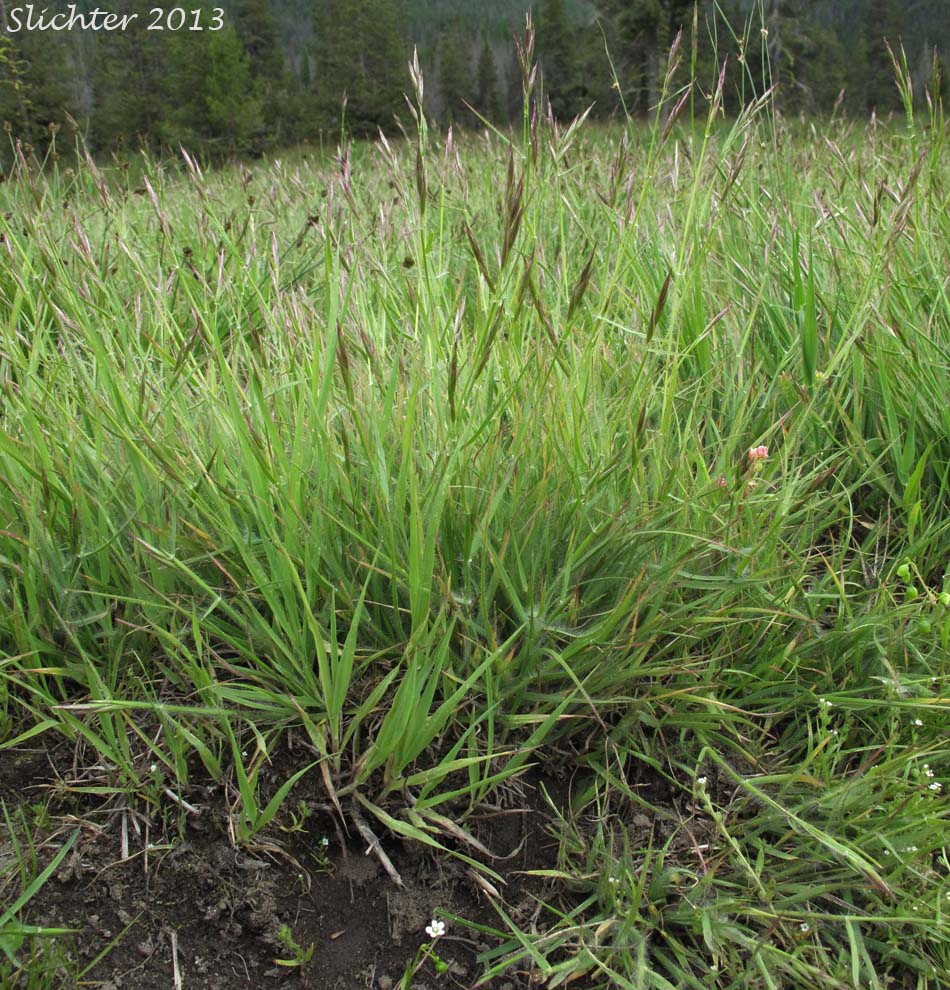Reproduction
California oatgrass is unique in the way it
reproduces because it contains two different types of seeds,
cleistogamous and chasmogamic seeds. The presence of each of these
seeds is very important in determining their life cycles. For
instance, cleistogamous seeds are formed from a closed flower
because they self-pollinate (Darris and Gonzalves 2008). However,
open flowers cross-pollinate which results in the production of
chasmogamic seeds which are known to have higher levels of
germination since they reproduce more quickly (Darris and Gonzalves
2008). Cleistogamy, or self-fertilization of a closed flower,
requires fewer plant resources, which can be beneficial when the
plant becomes attacked or damaged. The flowering of California oatgrass occurs between the
months of May and July when the temperatures are warmer, but don’t
expect to see flowering within the first year of growth. This
organism develops very slowly, so the second and third years are
more common for the initial site of flowering (Darris and Gonzalves
2008). Once California oatgrass begins to flower, those flowers
produce pollen. Unlike most other flowering plants, grasses do not
require insects to spread the pollen. Instead, California oatgrass
is anemophilous, or wind-pollinators. The pollen grains in these
seeds are transported by wind.
 Germination of this organism depends on many factors. First off,
dormancy can be very common in California oatgrass. An organism in
dormancy refers to the length of time that growth and development is
interrupted. Even if they are dormant in the ground, seeds in this
plant can still germinate. It has been shown that these seeds can
germinate more quickly if they are scattered and watered promptly
(Darris and Gonzalves 2008). Storage of the seeds at different
temperatures, overpopulation, aggressive seed
conditioning, and restricted gas exchange (Darris and Gonzalves
2008) are all things that play a role in California oatgrass being
dormant. Temperatures too low or too high can cause a seed to be
dormant, as well as overpopulation of organisms within the same
general area. The use of machines to plant the seeds can also
decrease the chance of them germinating (Darris and Gonzalves 2008);
seed dispersal should occur naturally. On the other hand, dormancy
can be beneficial when trying to maintain overpopulated areas by mowing (Wilson and Clark 2001), grazing
and burning (Hatch et al. 1999), and herbicides (Darris and
Gonzalves 2008). The picture above shows an unidentified
Danthonia, but is a good example of how compact these grasses
can be and still thrive in their environment. In 2001, Wilson and Clark performed an
experiment to show how mowing grasses at certain lengths can affect
the growth rates of those grasses. This type of experiment was also
constructed by Hatch and his colleagues in 1999 by using burning
methods, and also Darris and Gonzalves in 2008 with the use of
herbicides. More details of these experiments can be found on the
Adaptation page. Other organisms such as the
California Harvester ant and the
Pacific Shrew may use California oatgrass seeds as a source for
food, which is another benefit to maintaining this organism so it
does not overpopulate.
Germination of this organism depends on many factors. First off,
dormancy can be very common in California oatgrass. An organism in
dormancy refers to the length of time that growth and development is
interrupted. Even if they are dormant in the ground, seeds in this
plant can still germinate. It has been shown that these seeds can
germinate more quickly if they are scattered and watered promptly
(Darris and Gonzalves 2008). Storage of the seeds at different
temperatures, overpopulation, aggressive seed
conditioning, and restricted gas exchange (Darris and Gonzalves
2008) are all things that play a role in California oatgrass being
dormant. Temperatures too low or too high can cause a seed to be
dormant, as well as overpopulation of organisms within the same
general area. The use of machines to plant the seeds can also
decrease the chance of them germinating (Darris and Gonzalves 2008);
seed dispersal should occur naturally. On the other hand, dormancy
can be beneficial when trying to maintain overpopulated areas by mowing (Wilson and Clark 2001), grazing
and burning (Hatch et al. 1999), and herbicides (Darris and
Gonzalves 2008). The picture above shows an unidentified
Danthonia, but is a good example of how compact these grasses
can be and still thrive in their environment. In 2001, Wilson and Clark performed an
experiment to show how mowing grasses at certain lengths can affect
the growth rates of those grasses. This type of experiment was also
constructed by Hatch and his colleagues in 1999 by using burning
methods, and also Darris and Gonzalves in 2008 with the use of
herbicides. More details of these experiments can be found on the
Adaptation page. Other organisms such as the
California Harvester ant and the
Pacific Shrew may use California oatgrass seeds as a source for
food, which is another benefit to maintaining this organism so it
does not overpopulate.
A unique aspect of California oatgrass is that some seeds require
light to germinate, while others do not (Darris and Gonzalves 2008)
though it is not determined which type of seeds (cleistogamous or
chasmogamous) require a light source. This organism is also a
host for the Gloeotinia temulenta, a fungus that many other native
grasses host as well.
Don't go away! The last stretch of our adventure is on the
Interactions page!
